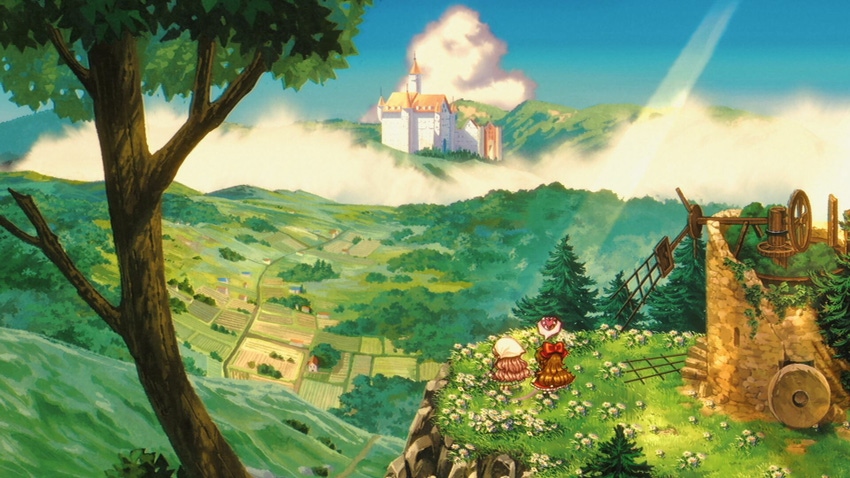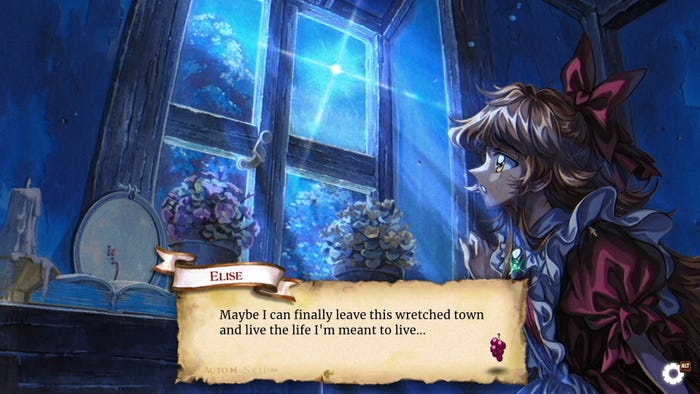
Weaving the vibrant fantasy world (and horrifying nighttime land) of Little Goody Two Shoes
Developer AstralShift talks about the artistic inspirations and thought processes that went into creating the beautiful daytime and horrifying nighttime of the fantasy world of Little Goody Two Shoes.

The IGF (Independent Games Festival) aims to encourage innovation in game development and to recognize independent game developers advancing the medium. Every year, Game Developer sits down with the finalists for the IGF ahead of GDC to explore the themes, design decisions, and tools behind each entry. Game Developer and GDC are sibling organizations under Informa Tech.
Little Goody Two Shoes seems like it’s taking players on a fairytale adventure in a beautiful land, but when night falls, it’s a constant battle against sinister creatures as you creep deeper into a terrifying forest.
Game Developer had a chat with the team at AstralShift, the game’s creators, to talk about the creation of the visual styles for the cheerful daytime and unsettling nighttime, the retro anime inspirations that went into creating its character artwork, and the thoughts that went into sneaking some terrifying elements into the bright, warm daytime as well as the frightening night.
Who are you, and what was your role in developing Little Goody Two Shoes?
Greetings! We’re AstralShift, an indie video game development studio based in Portugal.
What's your background in making games?
While we only began full-time activities as a studio quite recently in 2022, our project started much earlier than that with the release of our first game, Pocket Mirror (2016)—a free RPG Maker title that was fully developed as in our free time.
We knew right away from this experience that we had the passion and the drive for game development, and that we wanted to pursue it more seriously as our career. After the release of Pocket Mirror, the development team set out to begin working on our next project.

Images via Square Enix
How did you come up with the concept for Little Goody Two Shoes?
We wanted to flesh out the story of Elise, a minor but elusive character in the Pocket Mirror storyline, and provide answers to the [mysteries] surrounding her. Thus, the foundation for Little Goody Two Shoes was established and we set out on a journey that spanned over 6 years of development and hard work!
What development tools were used to build your game?
The larger, more ambitious scope of Little Goody Two Shoes provided new and exciting challenges for us to tackle as we transition from a more limited tool like RPG Maker to Unity, forcing us to acquire an entire new skillset to learn and master a new engine.
Little Goody Two Shoes immerses players in a beautiful fairytale world with its hand-painted art style. What drew you to work with this art style for your horror experience?
Our lead environment artist, Hika (Pedro Dias), is a prolific painter who has used poster paint in his work to render beautifully detailed backgrounds and illustrations. It’s thanks to his expertise that the world of Little Goody Two Shoes was able to come alive in such a memorable way.
This art style allowed us to build a visual language that could meaningfully convey Elise’s surroundings and what they represent to her: the warm and lively tones in which Kieferberg is portrayed in direct opposition to the Woodland areas that make-up the more sinister parts of the game. This striking contrast observed between the Day and Night sections emphasizes the feeling of being plunged into a fantastical and mystical world that contains as many horrors as it does beauty.

Images via Square Enix
Likewise, the game makes use of a retro anime style for its character artwork in places. What interested you in using this style for the characters?
From the early stages of development and conceptualization for Little Goody Two Shoes, we knew that we wanted to create a work where the visuals could say as much about the story, the world, and its characters, as the text of the narrative itself.
Our lead character artist, Kira (António Lopes), is heavily influenced by retro anime styles, specifically those from the 80’s, 90’s (after which Little Goody Two Shoes was conceptualized) and the early 2000’s. Since our game’s premise is that of a “fairytale with a horror twist,” we knew the chosen art style for the characters and environments alike had to evoke a sense of nostalgia in the player.
Many different artists and works served as inspiration to us at many stages of the development. Anime shows from the 90’s such as Revolutionary Girl Utena, Cardcaptor Sakura, and Magic Knights Rayearth were of incredible importance in informing Little Goody Two Shoes’ character style.
More contemporary influences include Puella Magi Madoka Magica, and the wonderfully talented animation circle INU CURRY, greatly inspired the more dreamlike sequences in Little Goody Two Shoes.
Can you tell us a bit about the visual design process for the protagonist, Elise?
When lead character designer Kira (António Lopes) sat down to create Elise, he had a very clear idea that her silhouette and color scheme had to be striking and bold. The color red is particularly prevalent and significant across the game and story, so it felt like a natural choice for Elise’s signature color.
Her design also immediately conveys Elise’s strong and determined personality. Her archetype is captured in an exaggerated rounded dress, the unruly and spike shapes of her hair, alongside her signature red bow—all these symbols portray a dreamy yet fierce heroine who looks like she could fit right in alongside the cast of a shoujo anime from the 1990’s.
Likewise, what ideas went into the design of the townsfolk, friends, and love interests Elise meets throughout the game?
As for the remainder of the cast, just like in Elise’s case, a lot of effort and emphasis was put on employing striking shapes to create memorable and unique silhouettes and character designs.
The love interests and other select characters clearly stand out in comparison to the remaining cast, highlighting their larger importance within the framework of the narrative. Nonetheless, they still look as if they belong within the world that they inhabit.

Images via Square Enix
What thoughts went into the differing gameplay styles of the day and night cycles of Little Goody Two Shoes? What ideas went into designing the different things players could do at different points in the day?
Little Goody Two Shoes’ horror elements are built on a striking atmosphere, building suspense and a growing fear of the unknown danger that faces Elise as she dives deeper into her own madness. To this end, we put a lot of effort into pairing the environments and soundscape of the game with gameplay elements that could elevate this feeling of dread or uneasiness.
Because Elise is unable to fight back against enemies, the player must figure out how they move and behave in order to outsmart them. Some enemies may be more relentless than others, forcing the player into an alarmed state. The key is in repetition, so we recommend players make ample use of their save slots and be prepared to die a few times!
What thoughts went into incorporating the need to avoid suspicions of witchcraft while making your way through Little Goody Two Shoes? Can you tell us a bit about how you developed this element of the game?
We took direct inspiration from folk horror tales for a lot of Little Goody Two Shoes’ overall narrative structure and game experience. One of these tropes is the outsider versus community archetype. While Elise isn’t an outsider to her own community, she most definitely feels like one, and we took advantage of the lack of trust between the townsfolk of Kieferberg and the protagonist to push a feeling of paranoia and the thread of persecution upon the player.
We weaved this theme into the gameplay through the use of the Suspicion meter, and tied everything together by putting Elise in game events that the player must resolve through the use of dialogue choices in order to keep Elise’s suspicion points at bay and avoid meeting an untimely end at the hand of the other villagers.
Little Goody Two Shoes touts ten different endings. What challenges come up from designing a story and gameplay that can be taken in ten different directions?
Throughout the story of Little Goody Two Shoes the player will be asked a series of questions: What are the consequences of Elise’s actions? Is it worth it to sacrifice everything to reach one’s goal? Can you find happiness in the connections you forge with other people?
Most of the game’s endings derive from Elise’s three love interests—Rozenmarine, Freya, and Lebkuchen. By exploring Elise’s relationship with each of these characters, the player will be asked to revisit these questions and frame them in a different light. The story builds in such a way that the player’s—and by extension Elise’s—decision will be narratively sound. Striking this balance was the most challenging aspect of the narrative, but we’re confident that the player will find resolution in their final decision no matter what it may be.
About the Author(s)
You May Also Like









